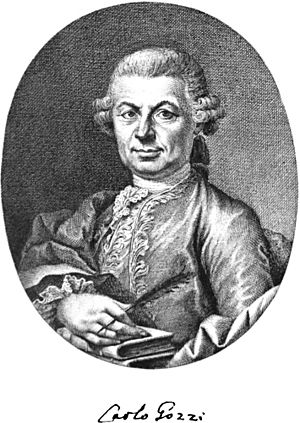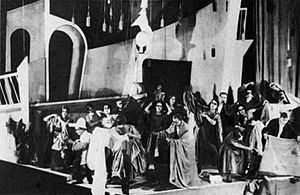Carlo Gozzi facts for kids
Carlo Gozzi was a famous Italian writer of plays, born in Venice on December 13, 1720. He loved and supported a special kind of Italian theater called Commedia dell'arte. He passed away in Venice on April 4, 1806.
Carlo Gozzi's Early Life
Carlo Gozzi was born and died in Venice, Italy. His family was part of the less wealthy noble class. When he was young, his family could not support him financially anymore. So, he joined the army in Dalmatia.
After three years, Gozzi returned to Venice. He joined a group called the Granelleschi Society. This society worked hard to protect Italian literature, especially from Tuscany, from foreign influences. They were very keen on saving traditional Italian comedy, like Commedia dell'arte.
Gozzi's Famous Plays
Two other Venetian writers, Pietro Chiari and Carlo Goldoni, were changing Italian theater. They were moving away from the old style that Gozzi and his society loved.
Saving Commedia dell'arte
In 1757, Gozzi wrote a funny poem to defend Commedia dell'arte. Then, in 1761, he wrote a comedy play based on a fairy tale. It was called The Love for Three Oranges. In this play, he made fun of Chiari and Goldoni's new style.
To put on his play, Gozzi worked with the Sacchi company. This was a Commedia dell'arte acting group. They had been out of work because people were losing interest in their style of theater. Gozzi's play was a huge hit! It helped the Sacchi company a lot. Gozzi then gave this play and his other fairy tale plays to Sacchi's group. This really helped save the company.
Some people say Gozzi saved Commedia dell'arte. However, there is a debate about this. Traditional Commedia dell'arte was mostly made up on the spot by actors. But Gozzi wrote out all his plays word for word.
Fairy Tale Plays
Gozzi saw how much audiences loved it when he added magical or mythical parts to his plays. So, he wrote many more plays based on fairy tales. These plays were very popular.
Gozzi's fairy tales were inspired by Commedia dell'arte. Their success helped bring back Commedia dell'arte in Italy. Famous writers like Johann Wolfgang von Goethe, the Schlegel brothers, and Ernst Theodor Amadeus Hoffmann praised these fairy tales.
One of his plays, Turandot, was translated by Friedrich Schiller. Goethe staged it in Germany in 1802, and it was a big success. Gozzi became famous across most of Europe. However, he was not as well-known in his own country.
Later Works
In his final years, Gozzi tried writing tragedies with funny parts. But these plays did not do well with critics. He then started working on Spanish plays and had some small successes. He was buried in the church of San Cassiano in Venice.
Gozzi's Personal Life
Carlo Gozzi was well known for his disagreements with Carlo Goldoni and Pietro Chiari. These arguments happened between 1756 and 1762. They were about the changing style of Italian theater. Gozzi wanted to keep the old style with masks and improvisation, which was typical of Commedia dell'arte.
Gozzi's brother, Gasparo Gozzi, was also a famous writer of that time.
Gozzi's collected works were published in 1792 in 10 volumes. Many stage works in the 20th century were inspired by Gozzi's plays. These include different versions of Turandot and operas based on the same story by Ferruccio Busoni and Giacomo Puccini. Also, Sergei Prokofiev's The Love of Three Oranges was based on Gozzi's work.
List of Gozzi's Plays
Fiabe Teatrali — "Tales for the Theatre"
- L'amore delle tre melarance — "The Love of Three Oranges" (1761)
- Il corvo — "The Raven" (1761)
- Il Re Cervo — "The Stag King" (1762)
- Turandot (1762)
- La donna serpente — "The Serpent Woman" (1762)
- La Zobeide (1763)
- I Pitocchi Fortunati — "The Fortunate Beggars" (1764)
- Il Mostro Turchino — "The Blue Monster" (1764)
- L'Augellino Bel Verde — "The Green Bird" (1765)
- Zeim, Re de' Geni — "Zeim, King of the Genies" (1765)
Other Plays
Gozzi wrote many other plays, including:
- Marfisa bizzarra (1766)
- The Elixir of Love (1775/1776)
- Il Cavaliere Amico; o sia, Il Trionfo dell'Amicizia — "The Knight; or, The Triumph of Friendship"
- La Vedova del Malabar — "The Widow of Malabar"
Other Works by Gozzi
- Ragionamento ingenuo, e storia sincera dell'origine delle mie dieci Fiabe teatrali — "An Honest Discussion and True Story of My Ten Tales for the Theatre" (1772)
- Memorie Inutili — "Useless Memoirs" (1777, published 1797)
See also
 In Spanish: Carlo Gozzi para niños
In Spanish: Carlo Gozzi para niños



